初中英语状语从句讲解
- 格式:doc
- 大小:46.00 KB
- 文档页数:6
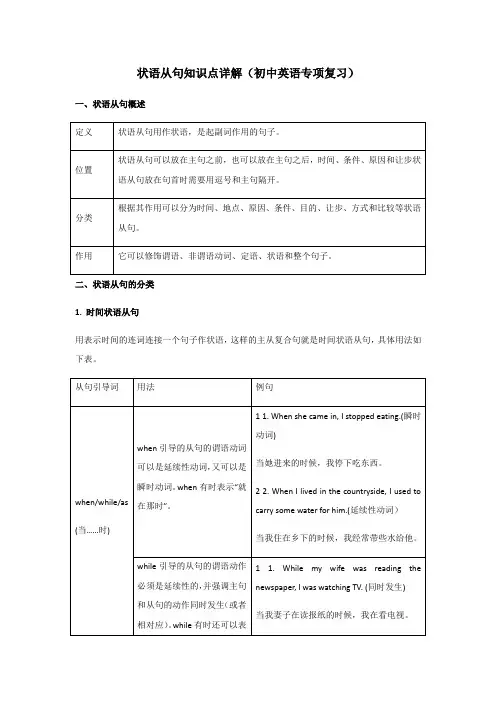
状语从句知识点详解(初中英语专项复习)一、状语从句概述二、状语从句的分类1. 时间状语从句用表示时间的连词连接一个句子作状语,这样的主从复合句就是时间状语从句,具体用法如下表。
2.结果状语从句结果状语从句的从句部分是补充说明主句中谓语动词发生的结果的,通常位于主句之后。
引导结果状语从句的从属连词如下表。
3. 目的状语从句:从句部分是用以补充说明主句中谓语动词发生的目的。
1). so that 以便……(达到某种目的)如:You must speak louder so that you can be heard by all.你要大点声说,这样大家就都能听到你了。
2). in order that 为了……,如:She got up early in order that she could get to school on time.=She got up early in order to get to school on time.为了能够准时到校,她很早起床。
4. 条件状语从句由连接词if或unless引导的状语从句叫做条件状语从句。
注意:1). unless 从句里的谓语只能是肯定式,因为unless本身表示否定;unless=if not,如:Let's go out for a walk unless you are too tired. =If you are not too tired, let's go out for a walk.如果你不是很累,我们出去散个步吧。
2). 在真实条件句中,主句不能用be going to表示将来,该用shall, will.如:If you will(愿意) wait a minute, I’ll go and tell my mother that you are here.如果你愿意等一分钟,我将去告诉我妈妈你在这里。
3). 下列从句中的will不是将来时助动词,而是情态动词。
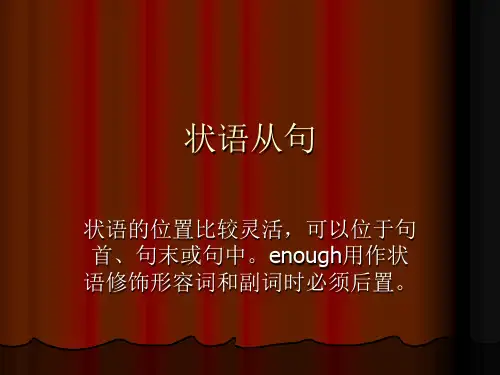

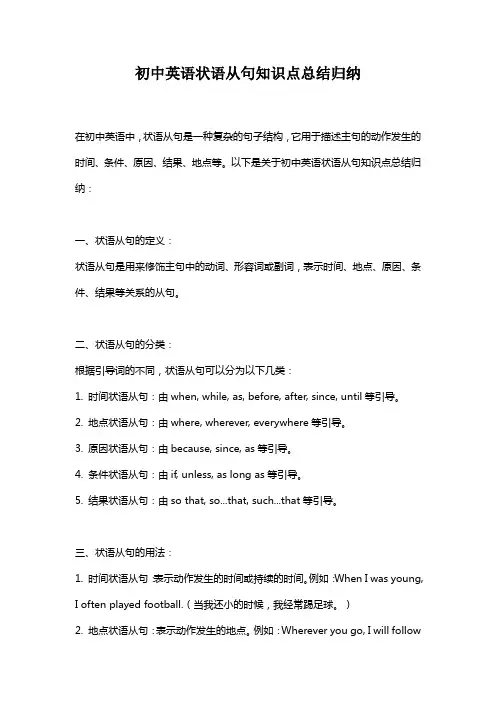
初中英语状语从句知识点总结归纳在初中英语中,状语从句是一种复杂的句子结构,它用于描述主句的动作发生的时间、条件、原因、结果、地点等。
以下是关于初中英语状语从句知识点总结归纳:一、状语从句的定义:状语从句是用来修饰主句中的动词、形容词或副词,表示时间、地点、原因、条件、结果等关系的从句。
二、状语从句的分类:根据引导词的不同,状语从句可以分为以下几类:1. 时间状语从句:由when, while, as, before, after, since, until等引导。
2. 地点状语从句:由where, wherever, everywhere等引导。
3. 原因状语从句:由because, since, as等引导。
4. 条件状语从句:由if, unless, as long as等引导。
5. 结果状语从句:由so that, so...that, such...that等引导。
三、状语从句的用法:1. 时间状语从句:表示动作发生的时间或持续的时间。
例如:When I was young,I often played football.(当我还小的时候,我经常踢足球。
)2. 地点状语从句:表示动作发生的地点。
例如:Wherever you go, I will followyou.(无论你去哪里,我都会跟着你。
)3. 原因状语从句:表示动作发生的原因。
例如:As it was raining, we had to stay indoors.(因为下雨了,我们不得不呆在室内。
)4. 条件状语从句:表示动作发生的条件。
例如:If it snows tomorrow, we will not go out.(如果明天下雪,我们就不出去了。
)5. 结果状语从句:表示动作发生的结果。
例如:She worked hard so that she could pass the exam.(她努力学习以便能通过考试。
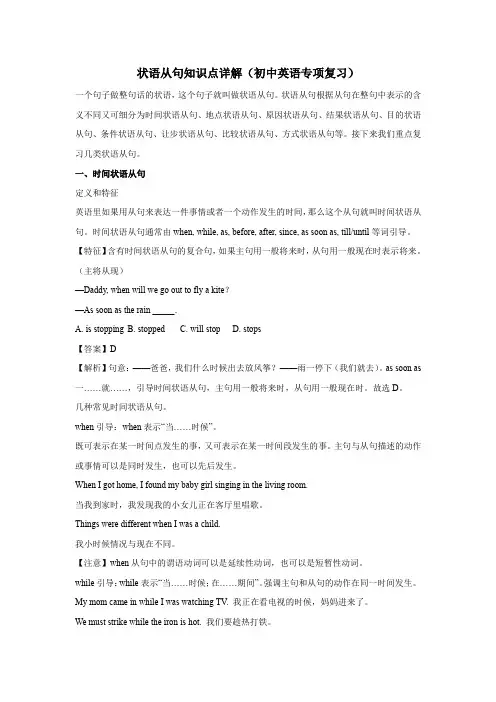
状语从句知识点详解(初中英语专项复习)一个句子做整句话的状语,这个句子就叫做状语从句。
状语从句根据从句在整句中表示的含义不同又可细分为时间状语从句、地点状语从句、原因状语从句、结果状语从句、目的状语从句、条件状语从句、让步状语从句、比较状语从句、方式状语从句等。
接下来我们重点复习几类状语从句。
一、时间状语从句定义和特征英语里如果用从句来表达一件事情或者一个动作发生的时间,那么这个从句就叫时间状语从句。
时间状语从句通常由when, while, as, before, after, since, as soon as, till/until等词引导。
【特征】含有时间状语从句的复合句,如果主句用一般将来时,从句用一般现在时表示将来。
(主将从现)—Daddy, when will we go out to fly a kite?—As soon as the rain _____.A. is stoppingB. stoppedC. will stopD. stops【答案】D【解析】句意:——爸爸,我们什么时候出去放风筝?——雨一停下(我们就去)。
as soon as 一……就……,引导时间状语从句,主句用一般将来时,从句用一般现在时。
故选D。
几种常见时间状语从句。
when引导:when表示“当……时候”。
既可表示在某一时间点发生的事,又可表示在某一时间段发生的事。
主句与从句描述的动作或事情可以是同时发生,也可以先后发生。
When I got home, I found my baby girl singing in the living room.当我到家时,我发现我的小女儿正在客厅里唱歌。
Things were different when I was a child.我小时候情况与现在不同。
【注意】when从句中的谓语动词可以是延续性动词,也可以是短暂性动词。
while引导:while表示“当……时候;在……期间”。


初中英语语法之状语从句类型及考点讲义状语从句概念解析状语从句指句子用作状语时,起副词作用的句子,可以修饰谓语、非谓语动词、定语、状语或整个句子,可分为时间、地点、原因、条件、目的、结果、让步、方式和比较等从句,是英语复合句学习的一个重点,在各类考试中都会经常出现,这次就来给大家讲解一下什么是状语从句。
1. 时间状语从句:常用引导词:when, as, while, as soon as, before, after, since , till, until特殊引导词:the minute, the moment, the second, every time, the day,the instant, immediately , directly, no sooner … than, hardly …when, scarcely … when instantlyI ran into the classroom as soon as the bell rang.2. 地点状语从句:常用引导词:where特殊引导词:wherever, anywhere, everywhereWherever the sea is , you will find seamen.3. 原因状语从句:常用引导词:because=in that, since=now that, as, for特殊引导词:seeing that, now that, in that, considering that, given thatI 'm late because I didn't caught the bus.4. 目的状语从句:常用引导词:so that, in order that特殊引导词: for fear that(唯恐/生怕),in the hope that, for the purpose that, to the end thatYou should book the hotel in advance so that the travel will be more easy.5.结果状语从句:常用引导词:so … that, such … that特殊引导词:such that, to the degree that, to the extent that, to such a degree thatHe is so young that he can't have meal by himself.6. 条件状语从句:常用引导词:if, unless,特殊引导词:as/so long as(只要), only if, providing/provided that(倘若), supposing that(倘若), in case that(以防), on condition thatYou can go to London as long as you have passport.7.让步状语从句:常用引导词:though, although, even if, even though特殊引导词: as(用在让步状语从句中必须要倒装),while,no matter …, in spite of the fact that, whatever, whoever, wherever, whenever, however, whichever, as if=as thoughThough we are old, we still can do these by ourselves.8. 比较状语从句:常用引导词:as(同级比较), than(不同程度的比较)特殊引导词:the more …the more …; just as …,so…,no … more than; not A so much as BShe is as pretty as her mother.9. 方式状语从句:常用引导词:as, as if, how特殊引导词:the wayHe didn't so it the way his brother did.辨析:while,when,as三者引导的时间状语从句时间状语从句算是状语从句中最简单的一类,也是我们日常生活交流中最常用的一类,虽然难度不大,但引导词也不少,仍然有不少同学会弄混那几个常见引导词的用法,这次就为大家带来as,when,while这几个词的辨析方法,一起看看吧。

初中英语知识点归纳状语从句的分类和用法状语从句是英语语法中重要的一部分,它用来修饰主句的动作或描述情况的,在句子中起着状语的作用。
状语从句分为时间状语从句、条件状语从句、原因状语从句、目的状语从句、结果状语从句、方式状语从句和比较状语从句等。
下面将对初中英语中常见的状语从句分类和用法进行归纳。
一、时间状语从句时间状语从句用来表示动作或事件发生的时间,包括连词when (当...时候),while (在...时候),before (在...之前),after (在...之后),as (当),since (自从),until (直到)等。
时间状语从句一般放在主句之前或者之后。
例如:- When I was young, I used to play soccer with my friends. (当我年轻的时候,我常常和朋友们踢足球。
)- After she finished her homework, she went to bed. (她完成作业之后,去睡觉了。
)二、条件状语从句条件状语从句用来表示主句动作的条件或前提,包括连词if (如果),unless (除非),in case (以防),as long as (只要),provided/providing (只要)等。
条件状语从句一般放在主句之前。
例如:- If it rains tomorrow, we will stay at home. (如果明天下雨,我们就在家呆着。
)- Unless you work hard, you won't pass the exam. (除非你努力学习,否则你就不能通过考试。
)三、原因状语从句原因状语从句用来表示主句动作或情况的原因,包括连词because (因为),as (因为),since (因为),for (因为),now that (既然)等。
原因状语从句一般放在主句之前。
例如:- Because it was raining, we stayed at home. (因为下雨,我们呆在家里。
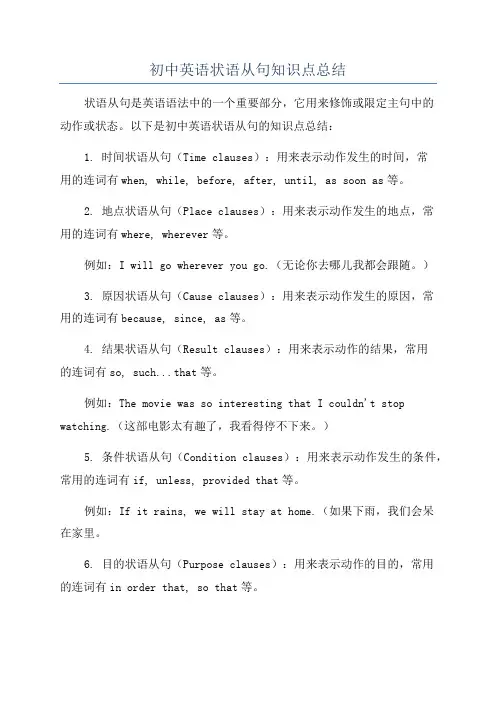
初中英语状语从句知识点总结状语从句是英语语法中的一个重要部分,它用来修饰或限定主句中的动作或状态。
以下是初中英语状语从句的知识点总结:1. 时间状语从句(Time clauses):用来表示动作发生的时间,常用的连词有when, while, before, after, until, as soon as等。
2. 地点状语从句(Place clauses):用来表示动作发生的地点,常用的连词有where, wherever等。
例如:I will go wherever you go.(无论你去哪儿我都会跟随。
)3. 原因状语从句(Cause clauses):用来表示动作发生的原因,常用的连词有because, since, as等。
4. 结果状语从句(Result clauses):用来表示动作的结果,常用的连词有so, such...that等。
例如:The movie was so interesting that I couldn't stop watching.(这部电影太有趣了,我看得停不下来。
)5. 条件状语从句(Condition clauses):用来表示动作发生的条件,常用的连词有if, unless, provided that等。
例如:If it rains, we will stay at home.(如果下雨,我们会呆在家里。
6. 目的状语从句(Purpose clauses):用来表示动作的目的,常用的连词有in order that, so that等。
例如:I bought a new notebook so that I can take notes in class.(我买了一个新笔记本,这样我可以在课堂上记笔记。
)7. 方式状语从句(Manner clauses):用来表示动作发生的方式,常用的连词有as, as if, as though等。
例如:He speaks as if he knows everything.(他说话的样子就像他什么都知道。
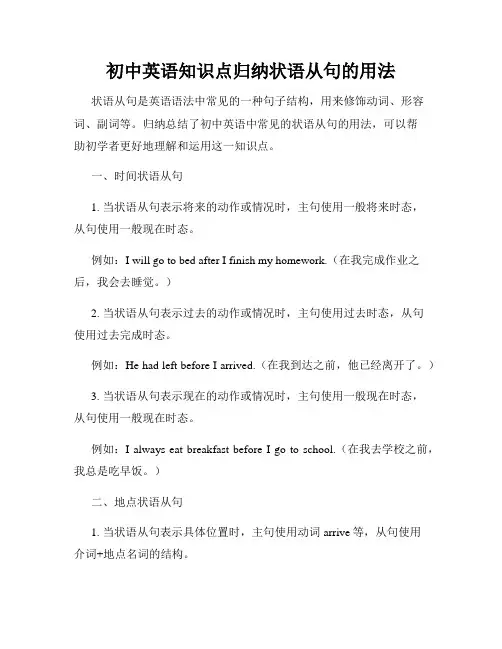
初中英语知识点归纳状语从句的用法状语从句是英语语法中常见的一种句子结构,用来修饰动词、形容词、副词等。
归纳总结了初中英语中常见的状语从句的用法,可以帮助初学者更好地理解和运用这一知识点。
一、时间状语从句1. 当状语从句表示将来的动作或情况时,主句使用一般将来时态,从句使用一般现在时态。
例如:I will go to bed after I finish my homework.(在我完成作业之后,我会去睡觉。
)2. 当状语从句表示过去的动作或情况时,主句使用过去时态,从句使用过去完成时态。
例如:He had left before I arrived.(在我到达之前,他已经离开了。
)3. 当状语从句表示现在的动作或情况时,主句使用一般现在时态,从句使用一般现在时态。
例如:I always eat breakfast before I go to school.(在我去学校之前,我总是吃早饭。
)二、地点状语从句1. 当状语从句表示具体位置时,主句使用动词arrive等,从句使用介词+地点名词的结构。
例如:We will meet at the place where we had lunch yesterday.(我们将在我们昨天吃午饭的地方见面。
)2. 当状语从句表示方向时,主句使用动词come/go等,从句使用连词where或标点符号将其与主句分开。
例如:He will go wherever you go.(无论你去哪儿,他都会去。
)三、原因状语从句1. 当状语从句表示结果时,主句使用so,主句中动词通常使用情态动词。
例如:I am ill, so I can't go to school.(我生病了,所以不能去学校。
)2. 当状语从句表示原因时,主句使用because,从句使用一般现在时态。
例如:He didn't eat breakfast because he got up late.(他早上起得晚,所以没有吃早饭。
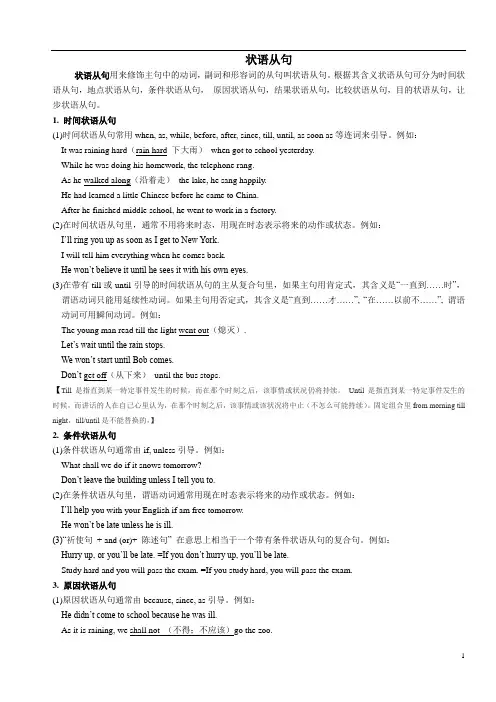
状语从句状语从句用来修饰主句中的动词,副词和形容词的从句叫状语从句。
根据其含义状语从句可分为时间状语从句,地点状语从句,条件状语从句,原因状语从句,结果状语从句,比较状语从句,目的状语从句,让步状语从句。
1. 时间状语从句(1)时间状语从句常用when, as, while, before, after, since, till, until, as soon as等连词来引导。
例如:It was raining hard(rain hard 下大雨)when got to school yesterday.While he was doing his homework, the telephone rang.As he walked along(沿着走)the lake, he sang happily.He had learned a little Chinese before he came to China.After he finished middle school, he went to work in a factory.(2)在时间状语从句里,通常不用将来时态,用现在时态表示将来的动作或状态。
例如:I’ll ring you up as soon as I get to New York.I will tell him everything when he comes back.He won’t believe it until he sees it with his own eyes.(3)在带有till或until引导的时间状语从句的主从复合句里,如果主句用肯定式,其含义是“一直到……时”,谓语动词只能用延续性动词。
如果主句用否定式,其含义是“直到……才……”, “在……以前不……”, 谓语动词可用瞬间动词。
例如:The young man read till the light went out(熄灭).Let’s wait until the rain stops.We won’t start until Bob comes.Don’t get off(从下来)until the bus stops.【Till是指直到某一特定事件发生的时候,而在那个时刻之后,该事情或状况仍将持续。
中考英语状语从句知识讲解状语从句即指在主从复合句用作状语的从句。按照其意义,状语从句可分为时间状语从句、地点状语从句、原因状语从句、目的状语从句、结果状语从句、条件状语从句、让步状语从句等。学习状语从句主要应注意引导状语从句的从属连词的用法与区别,以及从属连词在一定的语言环境中的意义与用法。一、时间状语从句1.引导时间状语从句的从属连词很多,常见的有before, after, when, while, as, since, till, until, as soon as 等。2.表示“当…时候”的 while, when, as 的用法区别是:while从句中的谓语动词必须是延续性动词;表示带有规律性的“每当”或当主、从句谓语动词的动作发生有先后时,只能用when;当表示“一边…一边…”或“随着”时,只能用as。另外,用于此义的 as 所引导的时间状语从句谓语只能是动作动词,不能是状态动词。如下面一道高考题的答案是B 而不能是A:“I’m going to the post office.” “_____ you’re there, can you get me some stamps?”A.AsB.WhileC.BecauseD.If3.until 在肯定句中通常只连用延续性动词,表示相应动作结束的时间;在否定句中通常连用非延续性动词,表示相应动作开始的时间,意为“直到…才”。如:He waited until she was about to leave.他等着一直到她准备离开。I did not begin to work till he had gone.他走了后我才开始工作。4.表示“一…就”除用as soon as 外,还可用the minute, the second, the instant, immediately, directly, instantly, no sooner…than, hardly…when等。如:I came immediately you called.你一来电话我就来了。Hardly had she arrived when it began to snow.她刚到就下起雪来了。The moment I have finished I'll give you a call.我一干完就给你打电话。5.every time, each time, (the) next time, (the) last time, by the time, the first time, any time 等以time 结尾的词语也可用作连词,引导时间状语从句。如: Next time you come in, please close the door.下次你进来,请关门。He didn’t tell me anything the last time I saw him.上次我见到他时他什么也没告诉我。By the time I got home, she had already gone to bed.我到家时她已睡觉了。二、条件状语从句1.引导条件状语从句的从属连词主要有 if, unless, as [so] long as等。如:Don’t come unless I telephone.除非我打电话,否则你别来。If you watch carefully you will see how to do it.如果你仔细瞧你会看出该怎样做。As long as you do your best, we’ll be happy.只要你尽力,我们就满意了。2.in case 也可引导条件状语从句,其意为“如果”、“万一”。如:In case I forget, please remind me about it.如果我忘了,请提醒我。三、让步状语从句1.引导让步状语从句的从属连词主要有 although, though, however (=no matter how), even if(即使), whether…or(不论…还是)等连词。如:The speech is good, though it could be better.这次演讲不错,虽然还可以再好一点。He went out even though it was raining.尽管下雨,他还是出去了。2.as 也可引导让步状语从句,但要将名词、形容词或副词等提到as 前,若提前的是单数可数名词,要省略 a / an。如:Teacher as he is, he can’t know everything.虽然是老师,他也不可能什么都懂。3.连词 while 有时也可表示“尽管”、“虽然”,引导让步状语从句。如:Wh ile we don’t agree we continue to be friends.尽管我们意见不同,我们还是朋友。4.whatever, whoever, however, whenever, wherever 等引导让步状语从句。如:Don’t lose heart whatever you do.不管你做什么,都不要灰心。Whoever you are, you can’t pass this way.不管你是谁,你都不能从这里通过。注:表示“虽然”的though, although 不可与but 连用,但可与yet,still 连用。四、原因状语从句1.引导原因状语从句的从属连词主要有because, as, since, seeing (that), now (that)等:They can’t have gone out because the light’s on.他们不可能出去了,因为灯还亮着。Since you are going, I will go.既然你去,我也去。Now that we are alone, we can speak freely.现在我们单独在一起,可以随便谈了。2.除以上提到的大家比较熟悉的引导原因状语从句的从属连词外,when有时也可引导原因状语从句,其意“既然”。如:I can’t tell you when you won't listen.既然你不想听,我就不告诉你了。3.有关原因状语从句还应注意以下几点:(1) as 与since, now that 一样表示双方都知道的原因,通常位于主句前,且均不可用于强调结构被强调。(2) 当表示直接的因果关系,回答why 时,或有only, just, all, partly, not, but 等副词修饰时,或用在强调结构中都只能用because。(3) for 有时也可引出表示原因的分句,但它只能位于后面,对前一分句加以解释或推断。(4) 不要受汉语意思影响将表示“因为”的连词与表示“所以”的so 连用。五、地点状语从句引导地点状语从句的从属连词主要有where (在…的地方), wherever(无论什么地方), everywhere(每个…地方), anywhere(任何…地方)。如:I’m not living where I was.我不在原处住了。You can’t camp where [wherever, anywhere] you like these days.如今你可不能随便在哪儿宿营。Everywhere I go, I find the same thing.不管我走到哪里,我都发现同样情况。2.有的同学认为地点状语从句在平时见得不多,误认为考试不会涉及,但恰恰相反,地点状语从句却是英语考试经常考查的一个知识点。请看以下考题:(1) When you read the book, you’d better make a ma rk _____ you have any questions.A.at whichB.at whereC.the place whereD.where(2) After the war, a new school building was put up _____ there had once beena theatre.A.thatB.whereC.whichD.when(3) You should make it a rule to leave things _____ you can find them again.A.whenB.whereC.thenD.there(4) She found her calculator ______ she lost it.A.whereB.whenC.in whichD.that以上四题均选where,其意为“在…的地方”,用以引导地点状语从句。六、目的状语从句1.引导目的状语从句的从属连词主要有in order that, so that, in case, for fear 等。如:I hired a boat so that I could go fishing.我租了一条船去钓鱼。Take your coat in case it rains (should rain).带着雨衣以防下雨。He studied hard in order that he could pass the exam.他努力学习,是为了能通过考试。2.引导目的状语从句的so that 有时可省so 或that,即单独用so 或that 来引导目的状语从句。如:Check carefully, so any mistake will be caught.仔细检查,以便任何错误都可检查出。Bring it closer that I might see it better.拿近些,使我能看得清楚些。七、结果状语从句引导结果状语从句的从属连词主要有so that, so…that, such…that等。如:He was so angry that he couldn't speak.他气得话都说不出来。He shut the window with such force that the glass broke.他关窗子用力很大,结果玻璃震破了。注:so…that和such…that中的that有时(尤其在口语中)可省略。八、比较状语从句引导比较状语从句的从属连词为as...as(和……一样),not as/so...as(和……不一样),than(比),the more...the more(越……越)。这类从句常以省略形式出现。如: The work is not so difficult as you imagine.这工作不像你想像的那么困难。You look younger than you are.你看上去比你的实际年龄要年轻。The more you study, the more knowledge you can get.你学的知识越多,你的知识越丰富。He doesn’t work as hard as she (does).他工作不像她那样努力。九、方式状语从句引导方式状语从句的从属连词有as(正如),as if或as though(好像)等。如:Do as I told you.按我告诉你的那样做。As a man lives, so he dies.正如人能活,也能死。I remember the whole thing as if it happened yesterday.整个这件事我记得很清楚,就仿佛是昨天发生似的。注:口语中like也可用连词引导方式状语从句。如:Do it like he does.照他那样做。She can’t cook like her mother does.她菜做得没有她妈那样好。。
初中英语九种状语从句归纳总结一、时间状语从句(Time adverbial clauses)时间状语从句用来表示一个动作或事件发生的时间。
常见的引导词有:when(当…时候)、while(当…的时候)、as(当…时候)、before (在…之前)、after(在…之后)、since(自从…以来)、until(直到…为止)、as soon as(一…就…)、whenever(无论何时)等等。
例如:- She likes to listen to music while she is cooking.(她喜欢一边做饭一边听音乐。
)- He went to bed after he finished his homework.(他做完作业后去睡觉了。
)二、地点状语从句(Place adverbial clauses)地点状语从句用来表示一个动作或事件发生的地点。
常见的引导词有:where(在哪里)、wherever(无论在哪里)等等。
例如:- I will meet you at the place where we first met.(我会在我们第一次见面的地方见你。
)三、方式状语从句(Manner adverbial clauses)方式状语从句用来表示一个动作或事件发生的方式。
常见的引导词有:as(以…方式)、as if(好像)、as though(好像)等等。
例如:- She sang the song as if she was performing on stage.(她唱歌的时候好像在舞台上表演一样。
)- He spoke English as though he was a native speaker.(他讲英语好像是母语一样。
)四、原因状语从句(Reason adverbial clauses)原因状语从句用来表示一个动作或事件发生的原因。
常见的引导词有:because(因为)、as(因为)、since(因为)、as long as(只要)等等。
初中英语语法学习之状语从句精讲英语状语从句是英语学习中的一个重要考点,下面将针对英语状语从句进行考点归纳。
一、时间状语从句时间状语从句是语法中的一个重要考点,下面是一些常见的时间状语从句:when:表示某个时间点或时间段,如“I will arrive at the airport when the plane takes off.”before:表示某个时间点或时间段之前,如“I will eat breakfast before I go to work.”after:表示某个时间点或时间段之后,如“I will finish my homework after I have dinner.”while:表示某个时间点或时间段持续,如“I was studying while she was sleeping.”as soon as:表示某个时间点或时间段一过去就发生,如“I will call you as soon as I get home.”until:表示某个时间点或时间段一直持续,如“I won't leave until I have finished my work.”since:表示某个时间点或时间段以来,如“I have been living in this city since I moved here last year.”when/while/as:这些词都可以引导时间状语从句,但它们的使用略有不同,需要根据具体语境选择使用哪个。
需要注意的是,如果主句是一般将来时,从句只能用一般现在时,如“I will go to the store tomorrow”中的“tomorrow”就是时间状语从句。
二、地点状语从句地点状语从句是语法中的一个重要考点,下面是一些常见的地点状语从句: where:表示某个地点,如“I will go to the store where I bought the groceries.”that:表示某个地点或位置,如“I saw a beautiful sunset over that mountain.”which:表示某个地点或位置,如“The building which is on fire needs to be evacuated immediately.”where/that/which:这些词都可以引导地点状语从句,但它们的使用略有不同,需要根据具体语境选择使用哪个。
初中英语状语从句讲解一、时间状语从句时间状语从句表示时间,引导词有:when, while, as, till, until before, after, since等。
时间状语从句的引导词所表示的意思不尽相同,要注意把握不同引导词所表示的不同时间关系,以及它在具体句子中对应的时态、语态等问题。
注意:as(在……时候,因为),since(自从,因为),它们可以引导时间从句,并强调主句和从句的动作同事发生。
并且while有时还可以表示对比。
例如:(1)While my mother was reading the newspaper, I was watching TV.(read是延续性的动词,read和watch同事发生)I like playing football while you like playing basketball.我喜欢踢足球,而你喜欢打篮球。
(对比)(2)when(当……的时候),引导的从句的谓语动词可以是延续性动词,也可以是瞬间动词。
从句动作可与主语动作同事发生,也可在其后发生。
I was reading a book when she came into my room.(come是瞬间动词,只能用when引导,不能用while)I often missed my home when(while) I lived in NewYork.(live是延续性动词,when可用while代替)(3)when和while的区别还在于:while引导的时间状语从句多用于进行时态,而when引导的时间状语从句多用于一般时态。
While they were talking, the bell rang.正在他们谈话的时候,上课铃响了。
(4)as译作 “一边……一边”、“随着……”,侧重主句和从句的动作同时发生。
有时可与when,while通用。
We always sing as we walk.我们总是边走边唱。
初中英语状语从句讲解1.时间状语从句2. 条件状语从句3. 原因状语从句4. 结果状语从句5. 比较状语从句6. 目的状语从句7. 让步状语从句8. 地点状语从句2.用来修饰主句中的动词,副词和形容词的从句叫状语从句。
根据其含义状语从句可分为时间状语从句,地点状语从句,条件状语从句,原因状语从句,结果状语从句,比较状语从句,目的状语从句,让步状语从句。
1. 时间状语从句(1)时间状语从句常用when, as, while, before, after, since, till, until,as soon as等连词来引导。
例如:It was raining hard when got to school yesterday.While he was doing his homework, the telephone rang.As he walked along the lake, he sang happily.He had learned a little Chinese before he came to China.After he finished middle school, he went to work in a factory.(2)在时间状语从句里,通常不用将来时态,用现在时态表示将来的动作或状态。
例如:I’ll ring you up as soon as I get to New York.I will tell him everything when he comes back.He won’t believe it until he sees it with his own eyes.(3)在带有till或until引导的时间状语从句的主从复合句里,如果主句用肯定式,其含义是“一直到……时”,谓语动词只能用延续性动词。
如果主句用否定式,其含义是“直到……才……”, “在……以前不……”, 谓语动词可用瞬间动词。
例如:The young man read till the light went out.Let’s wait until the rain stops.We won’t start until Bob comes.Don’t get off until the bus stops.2. 条件状语从句(1)条件状语从句通常由if, unless引导。
例如:What shall we do if it snows tomorrow?Don’t leave the building unless I tell you to.(2)在条件状语从句里,谓语动词通常用现在时态表示将来的动作或状态。
例如:I’ll help you with your English if am free tomorrow.He won’t be late unless he is ill.(3)“祈使句 + and (or)+ 陈述句”在意思上相当于一个带有条件状语从句的复合句。
例如:Hurry up, or you’ll be late.=If you don’t hurry up, you’ll be late.Study hard and you will pass the exam.=If you study hard, you will pass the exam.3. 原因状语从句(1)原因状语从句通常由because, since, as引导。
例如:He didn’t come to school because he was ill.As it is raining, we shall not go the zoo.Since you can’t answer the question, I’ll ask someone else. (2)because表示直接原因,语气最强。
Because引导的原因状语从句多放在主句之后。
回答由why提出的问题,只能用because。
As和since语气较弱,一般用来表示明显的原因。
由as和since引导的原因状语从居多放在句首。
例如:------Why aren’t going there?------Because I don’t want to.As he has no car, he can’t get there easily.Since we have no money, we can’t buy it.(3)because和so不能同用在一个句子里。
4. 结果状语从句(1)结果状语从句由so…that, such…that, so that引导。
例如:He is so poor that he can’t buy a bike for his son.She is such a good teacher that everybody likes her.My pencil fell under the desk, so that I couldn’t see it.(2)so…that语such...that可以互换。
例如:在由so...that引导的结果状语从句中,so是副词,与形容词连用。
其结构是: “...so + 形容词(副词)+ that + 从句”。
例如:He was so glad that he couldn’t say a word.The hall is so big that it can hold 2,000 people.Mother lives so far away that we hardly ever see her.在由such…that引导的结果状语从句中,such是形容词,它修饰的可以是单数或复数可数名词,也可以是不可数名词;名词前面可以带形容词,也可不带。
如果是单数可数名词,前面需加不定冠词a或an。
例如:It was such a hot day that nobody wanted to do anything.He had such long arms that he could almost touch the ceiling.He made such rapid progress that he did very well in the mid-term.有时上述两种结构是可以互换的。
例如:It was such a wonderful film that all of us wanted to see it again. =The film was so wonderful that all of us wanted to see it again. It is such an important match that nobody wants to miss it.=The match is so important that nobody wants to miss it.(3)如果名词前由many, much, little, few等词修饰时,只能用so, 不用such。
例如:Soon there were so many deer that they ate up all the wild roses.He has so little time that he can’t go to the cinema with you.5. 比较状语从句比较状语从句通常由as…as, 比较级 + than…等连词引导。
例如:Tom runs faster than John does.This classroom is as big as that one.6. 目的状语从句(1)目的状语从句通常由 so that, in order that引导。
例如:We started early so that we could catch the first train.He studies hard so that he could work better in the future.We used the computer in order that we might save time.(2)so that既可引导目的状语从句,又可引导结果状语从句。
区别这两种从句的办法有两个:1)目的状语从句里往往带有情态动词can, could, may, might等。
2)从意思上看,目的状语从句往往表示的目的很明确。
例如:Speak clearly so that they may understand you. (目的状语从句)Jack is badly ill so that he has to rest. (结果状语从句)7. 让步状语从句(1)让步状语从句通常由although, though等连词引导。
例如:Though he is young, he knows a lot.Although I am tired, I must go on working.(2)although(though)不能用在同一个句子中。
例如:我们不能说:Though it was raining hard, but he still went out.应该说:Though it was raining hard, he still went out.或It was raining hard, but he still went out.8. 地点状语从句地点状语从句常常由where来引导。
例如:Go where you like.Where there is a will, there is a way.【实例解析】1.You will stay healthy _______ you do more exercise, such as running and walking.A. ifB. howC. beforeD. where答案:A。
该题考查的是引导状语从句的从属连词的选择。
从意思上看,从句应是一个条件状语从句,在这四个选项中只有if能引导条件状语从句,所以选A。
2. ---Shall we go on working?---Yes, _________ I prefer to have a rest.A. whenB. ifC. becauseD. though答案:D。
该题考查的是引导状语从句的从属连词的选择。
从意思上看,只有选though才能说得通。
3.None of us knew what had happened _________ they told us about it.A. whenB. untilC. afterD. though答案:B。